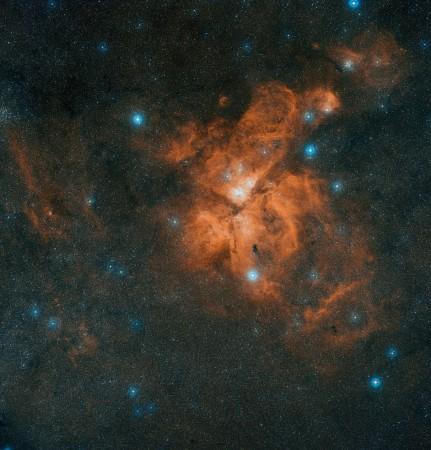
The European Southern Observatory (ESO), has been studying the deep space for long and now released some of the most breathtaking images to have ever been shot capturing the Carina Nebula—one of the Milky Way Galaxy's largest and brightest nebulae.
Images were photographed using ESO VISTA telescope that is stationed at the Paranal Observatory in Chile, notes a release put out by the observatory. Infrared light, though invisible to the human eye, is good at cutting through large clouds of gas and dust, so by looking for infrared light, in the universe, it is possible to see through the hot gas and dark dust that enshrouds this nebula and VISTA has been able to, as a result, see thousands of stars, both being born as well as just about dying.
Carina Nebula is about 7,500 light years away in the Carina constellation, notes the ESO. Here, stars are born and die out almost constantly. As a result of these dramatic events, Carina Nebula is an interesting, dynamic and ever-evolving region in the night sky.

Massive stars on the inside of this nebula have been found to emit radiation so intense that it causes surrounding gases to glow. At the same time, the nebula also has several "dark pillars" of dust that curtain newborn stars.
ESO says that there is an ongoing interstellar battle that is raging between the stars one side and dust on the other within the Carina Nebula. As of now, newly-formed stars seem to be winning— producing high energy radiation, coupled with stellar winds, they are dispersing and evaporating the dust-filled nurseries from whence they were formed.
To put into perspective just how big the Carina Nebula is, the report mentions that it is about 300 light years wide. It is one of the Milky Way's largest star-birthing centres and is actually visible from Earth, provided it is seen from a dark site. It lies, unfortunately, about 60 degrees below the "celestial equator", so it can only be seen from the Southern Hemisphere, hence the ESO's observatory is in Chile.

Within this intriguing nebula, Eta Carinae takes pride of place as the most peculiar star system. This stellar behemoth — a curious form of stellar binary— is the most energetic star system in this region and was one of the brightest objects in the sky in the 1830s. It has since faded dramatically and is reaching the end of its life, but remains one of the most massive and luminous star systems in the Milky Way.
Eta Carinae, the star, is seen in the bright patch of light above V-shape dust clouds in the centre of the image. To the right of Eta Carinae is the small "Keyhole Nebula". It hosts a few massive stars, and its appearance has reportedly changed drastically over the last few centuries, notes the ESO.














